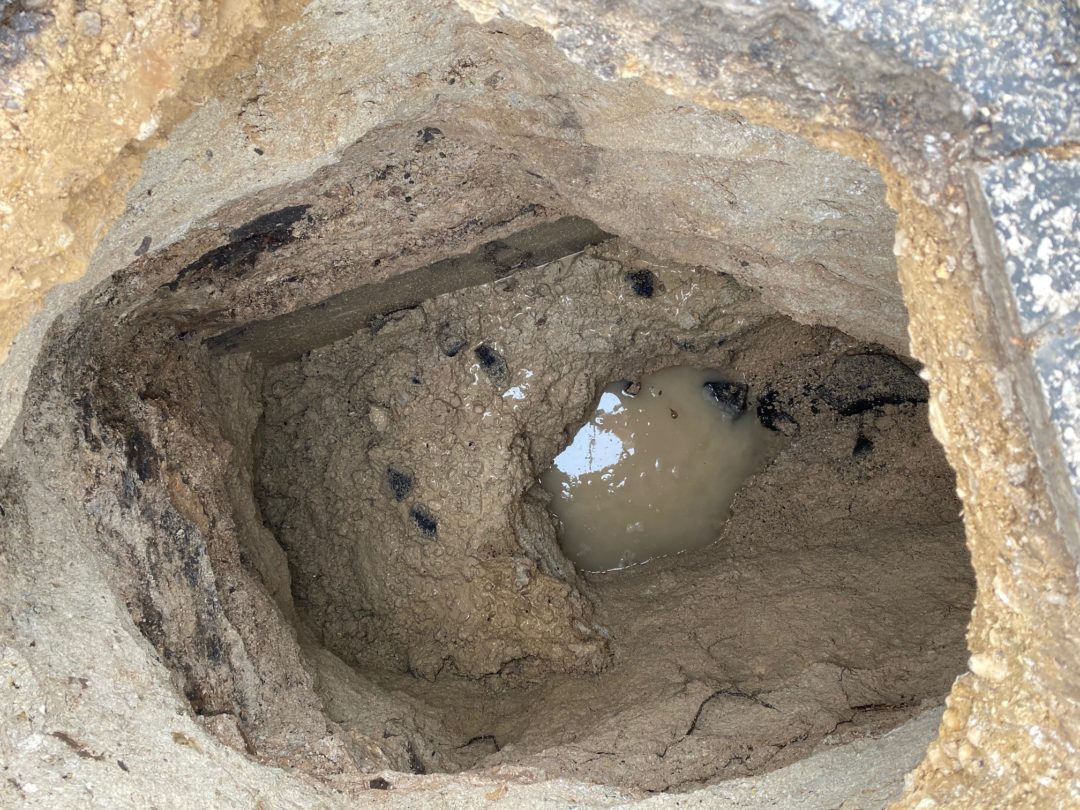Survey Technician III David Leyendecker explains how ingenuity and unconventional thinking led to him becoming known as “Sinkhole MacGyver.”
The sinkhole was only a foot in diameter, but the danger it presented shut down most of the roadway.
The sinkhole was only a foot in diameter, but the danger it presented shut down most of the roadway. When Pape-Dawson Engineers sent experts to study it, they found a bell-shaped washout at least eight feet deep. They knew they would need better information to diagnose the problem, fix it, and save the concrete structures it undercut.
There was no easy way to get the data the engineers needed. A survey technician can often climb into a hole or ditch using a ladder, pipework, or other support. But nothing firm enough presented itself. This wouldn’t be easy.
That’s when Survey Technician III David Leyendecker entered the story.
“Usually we can climb down, affix the scanner to a pipe or something, then operate it remotely. We couldn’t do that here,” he says. David had done plenty of scanning jobs since Pape-Dawson bought its first terrestrial scanner in 2013, but nothing quite like this.
His ingenuity kicked in. He usually operates the shoebox-sized scanner mounted atop a tripod. Though it would be unconventional, couldn’t he rig the tripod so the scanner hung below it instead? After a few minutes, he’d proved his idea’s feasibility.
A construction crew widened the hole to 18 inches in diameter. With the inverted tripod straddling the gap, David took measurements for 45 minutes, accomplishing one scan above ground, one at ground level, and two within the hole itself. With that data, engineers could accurately assess the problem, including the hole’s extent and water source.
That’s the project that earned David the nickname “Sinkhole MacGyver,” but it’s far from the only unique application of his skills and equipment. Surveying careers brim with adventure, and his is no exception. Since his early days experimenting with Pape-Dawson’s first scanner in 2013, he’s done a wide variety of internal and external work. As word got around, projects got more numerous and more interesting.
David recalls with pride a drainage channel measuring 3,000 feet long and 10 feet wide. Portions of it dated back more than one hundred years, and historical standards dictated that the original walls be fully documented before replacing them. He has also recorded historical sites, sometimes scanning 250,000-square-foot properties with five or more stories. Though focus- and skill-intensive, scanning can shorten a project like this from months to weeks.
Not only is the work more efficient, engineers get much more detailed information. In one memorable commercial job, David estimated he would finish a historical building in about 200 scans. The first floor by itself took 300 scans, though, and the entire project took 580 (each of them two to three minutes long), totaling 64 work hours.
The same job with a conventional total station and data collector would require three-person crews for several weeks and glean much less information. “They’d shoot elevation and walls and get the layout. As for details, they’d maybe record major electrical conduits, pipes, some light fixtures … but really the absolute minimum info,” David says. His LiDAR scanner, on the other hand, emits and receives millions of laser bursts, each one contributing to a detail-rich picture that can identify minute physical aspects of the space.
In addition to standard surveying jobs, David’s work has helped engineers and architects make enlightened decisions on how to best preserve historic structures and incorporate them into new designs. He has documented ancient construction for future generations.
And thanks to David, cars are once again safely driving over pavement once threatened by a mysterious sinkhole.




